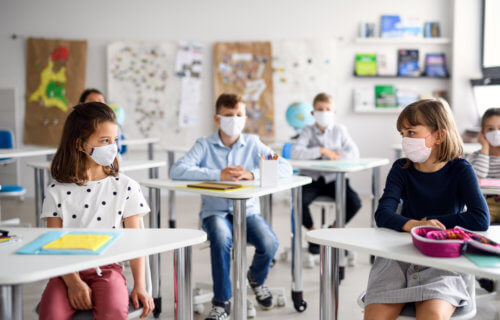LONDON — Ideally, air pollution is something to avoid at all times. Unfortunately, there are certain places where we can at least expect to encounter dirtier air, such as in the heart of a big city or along a highway backed up with bumper-to-bumper traffic. Now, however, a new study finds six in 10 classrooms actually have worse air quality than traffic-filled roads.
Researchers in the United Kingdom handed out digital pollution monitors to both teachers and students attending 26 U.K. schools on 10 different occasions. Some of the most frequent pollutants detected by those monitors were volatile organic compounds. These pollutants can come from plastics, glues, disinfectants, and solvents. Additionally, the monitors also recorded fine dust and suspended aerial liquid droplets, which are usually byproducts of heating, cooking, and transportation.
Notably, some of the schools in the study were located in big cities, while others were in smaller towns and villages. Surprisingly, location doesn’t seem to make much difference; indoor air pollution in village classrooms was just as bad as in urban areas.
Some readings even showed air pollution exceeding the one-hour exposure threshold set by the World Health Organization. In other words, students may be at risk of adverse health effects by continually breathing this air.
This study was commissioned by natural daily nasal wash Otrivine Natural as part of an initiative called “Actions to Breathe Cleaner.”
9 in 10 students are breathing in air pollution
According to the WHO, 93 percent of children all over the world breathe in polluted air every single day. The WHO recently deemed air pollution the largest global environmental health threat.
“We want to inspire people to take action against the health impact of air pollution because children contribute the least to it but are some of the most vulnerable to its effects. One of the first steps is to be aware of your personal exposure and then learn the actions you can take to breathe cleaner,” comments Sarah McDonald, GSK VP of Sustainability, in a statement.
“We discovered that indoor air quality can be worse than outdoors and therefore, as part of Actions to Breathe Cleaner, we recommend daily ventilation of classrooms, at times when outside traffic is at its lowest. Also, let’s not forget that our noses are our first line of defense, so another action is to wash your nose daily.”
The study also reports that while most students know air pollution is bad, they don’t know what they should do about it. Luckily, after participating in the “Actions to Breathe Cleaner” initiative, students’ general knowledge on air pollution and how to avoid it increased by 54 percent.
During the project, participating students analyzed the air quality inside and outside their schools over the course of two weeks via digital pollution monitors. Students had to monitor the quality of the air outside at one location for 15 minutes, during a 15 to 30-minute walk outside, and then once more inside the classroom for 15 minutes after the walk. Monitors inside the classrooms helped to gauge daily indoor pollution rhythms.
Furthermore, another 4,000 children participated in the project via a bespoke educational program that focused on classroom learning. Since the conclusion of the project, many participating schools tell researchers that they’ve started taking steps to improve indoor air quality, such as adding more plants.

